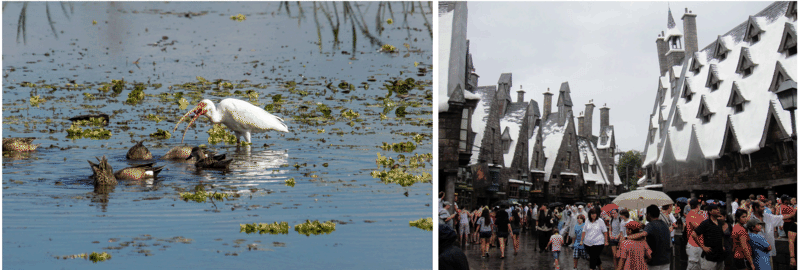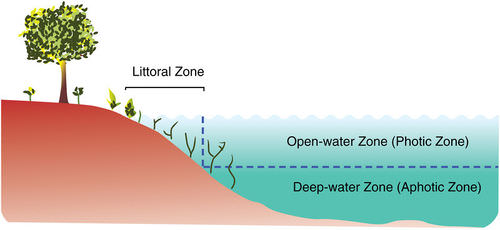18.6淡水生态系统
章节大纲
-
Lesson
::经验教训What do the swamps of Florida look like?
::佛罗里达的沼泽是什么样的?Orlando, Florida is home to many amusement parks. On the left is a swamp with swamp wildlife. On the right is the village of Hogsmeade, or at least a replica. The Wizarding World of Harry Potter is one of the many amusement parks in and around Orlando. These amusement parks are built on land that was mostly lakes and swamps.
::奥兰多,佛罗里达州有许多游乐园。左边是沼泽地,有沼泽野生动物。右边是霍斯梅德村,或至少是复制品。哈利波特巫师世界是奥兰多及其周围许多游乐园之一。这些游乐园建在大部分是湖泊和沼泽的土地上。Freshwater Ecosystems
::淡水生态系统Lakes, ponds , streams , springs, and wetlands are fresh water bodies. The organisms that live in them are part of freshwater ecosystems . These ecosystems vary by , pressure (in lakes), and the amount of light that penetrates. The type of plants that grow in these ecosystems varies.
::湖泊、池塘、溪流、泉水和湿地是淡水体。其中的生物是淡水生态系统的一部分。这些生态系统因压力(湖泊)和渗入的光量而不同。在这些生态系统中生长的植物类型各不相同。Lake Ecosystems
::湖湖生态系统Limnology is the study of the plants and animals that live in fresh water bodies. A lake has zones just like the ocean. The ecosystem of a lake is divided into three distinct zones ( Figure ):
::岩石学是对生活在淡水体中的植物和动物的研究。湖有与海洋相同的区域。湖生态系统分为三个不同的区域(图 ):- The surface (littoral) zone is the sloped area closest to the edge of the water.
::表面(沿岸)区域是离水边最接近的斜坡区域。
- The open-water zone (also called the photic zone ) has sunlight.
::开水区(亦称甲状腺区)有阳光。
- The deep-water zone (also called the aphotic zone ) has little or no sunlight.
::深水区(又称光层)很少或没有阳光。
There are several life zones found within a lake:
::在湖中发现了几个生命区:- In the littoral zone , sunlight allows plants to grow. Plants provide food and shelter to animals such as snails, insects, and fish.
::在沿岸地带,阳光使植物得以生长,植物为蜗牛、昆虫和鱼类等动物提供食物和栖身之处。
- Other plants and fish live in the open-water zone. These include bass and trout.
::其他植物和鱼类生活在开阔水区,包括贝斯和鳟鱼。
- The deep-water zone is dark so there is no photosynthesis . Most deep-water organisms are scavengers . They feed on dead organisms that fall to the bottom of the lake. Crabs and catfish are two of these types of organisms. Fungi and bacteria are decomposers that live in the deep zone.
::深水区是黑暗的,因此没有光合作用,大多数深水生物都是清扫工,它们以沉入湖底的死生物为食,螃蟹和是这两种生物,蘑菇和细菌是深海区分解生物。
The three primary zones of a lake are the littoral, open-water, and deep-water zones.
::湖泊的三个主要区是沿岸、开阔水和深水区。Wetlands
::湿地Some of Earth’s freshwater is found in wetlands. A wetland is an area that is covered with water, or at least has very soggy soil , during all or part of the year . Certain species of plants thrive in wetlands, and they are rich ecosystems. Freshwater wetlands are usually found at the edges of streams, rivers , ponds, or lakes. Wetlands can also be found at the edges of seas.
::地球上的一些淡水在湿地中找到。 湿地是全年或全年或部分时间内被水覆盖的地区,或至少有非常肥沃的土壤。 某些植物物种在湿地生长,它们是丰富的生态系统。 淡水湿地通常在溪流、河流、池塘或湖泊的边缘发现。 湿地也可以在海洋边缘找到。Types of Freshwater Wetlands
::淡水湿地类型Not all wetlands are alike, as you can see below ( Figure ). Wetlands vary in how wet they are and how much of the year they are soaked. Wetlands also vary in the kinds of plants that live in them. This depends mostly on the climate where the wetland is found. Types of wetlands include marshes , swamps, and bogs .
::并非所有湿地都是一样的,如下图所示(图 ) 。 湿地的湿度和湿度各不相同,湿地的植物种类也不同,这主要取决于湿地所在的气候。湿地的类型包括沼泽、沼泽和沼泽。- A marsh is a wetland that is usually under water. It has grassy plants, such as cattails.
::沼泽地是湿地,通常在水下,它有青草,如尾巴。
- A swamp is a wetland that may or may not be covered with water but is always soggy. It has shrubs or trees.
::沼泽地是湿地,可能或可能没有水覆盖,但总是肥嫩,有灌木或树木。
- A bog is a wetland that has soggy soil. It is generally covered with mosses.
::沼泽是一个湿地,土壤肥沃,通常被苔胱覆盖。
These are just three of many types of wetlands.
::这些湿地只是许多类型湿地中的三种。Importance of Wetlands
::湿地的重要性People used to think that wetlands were useless. Many wetlands were filled in with and soil to create solid land. This land was then developed with roads, golf courses, and buildings. Now we know that wetlands are very important. Laws have been passed to help protect them. Why are wetlands so important?
::人们常常认为湿地是无用的。许多湿地被填满,土壤被填满以创造坚固的土地。然后,这片土地被用道路、高尔夫球场和建筑来开发。现在,我们知道湿地非常重要。已经通过了法律来保护湿地。为什么湿地如此重要呢?- Wetlands have great biodiversity . They provide homes or breeding sites to a huge variety of species. Because so much wetland area has been lost, many of these species are endangered.
::湿地拥有丰富的生物多样性,它们为各种物种提供家园或繁殖地,由于丧失了太多的湿地地区,其中许多物种濒临灭绝。
- Wetlands purify water. They filter sediments and toxins from runoff before it enters rivers, lakes, and oceans.
::湿地净化水,在径流进入河流、湖泊和海洋之前过滤沉积物和毒素。
- Wetlands slow rushing water. During and other extreme , wetlands reduce the risk of floods.
::湿地缓慢流水,在湿地期间和其他极端情况下,湿地可减少洪水风险。
Although the rate of loss has slowed, wetlands are still being destroyed today.
::虽然损失速度减缓,但湿地今天仍在被毁坏。Summary
::摘要- The conditions that affect lake ecosystems are similar to those that affect ocean ecosystems. These include light penetration, temperature, and water depth.
::影响湖泊生态系统的条件与影响海洋生态系统的条件相似,包括光渗透、温度和水深。
- Wetlands are lands that are wet for a significant portion of the year.
::湿地是一年中大部分时间湿润的土地。
- Wetlands are extremely important as an ecosystem and as a filter for pollutants.
::湿地作为生态系统和污染物过滤器极为重要。
Review
::回顾- Compare and contrast the zones found in lakes.
::比较和对比湖泊中发现的区域。
- For many decades, people drained wetlands. Was this a good idea or a bad idea? Why?
::几十年来,人们排干湿地。这是个好主意还是坏主意?为什么?
- Compare and contrast the three main types of wetlands.
::比较和比较三个主要类型的湿地。
- The surface (littoral) zone is the sloped area closest to the edge of the water.


